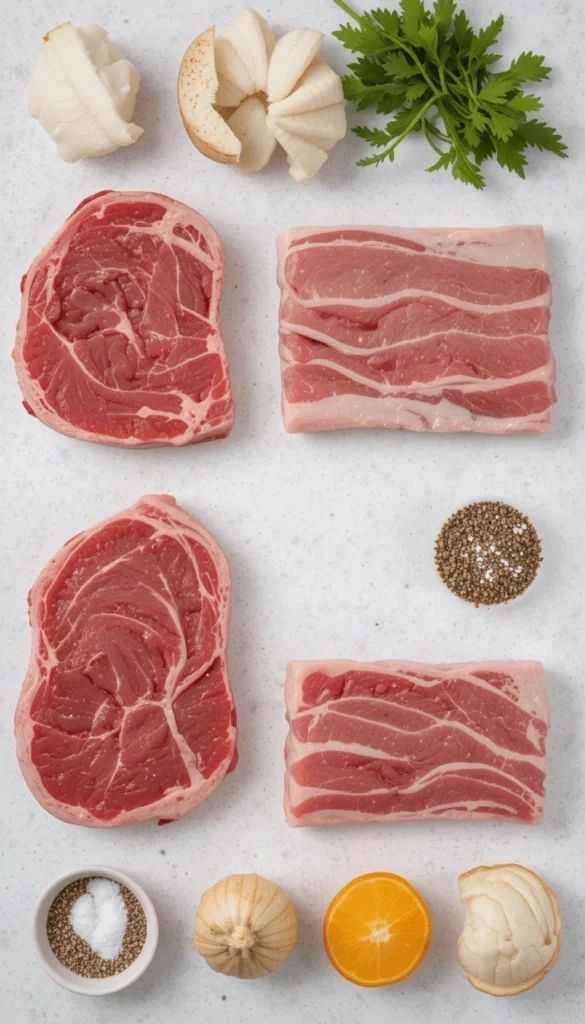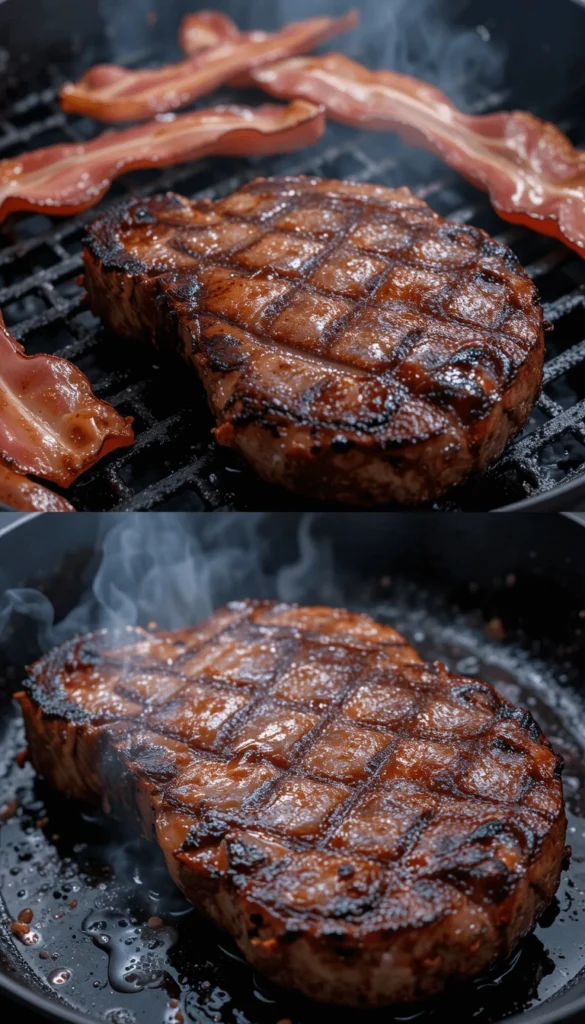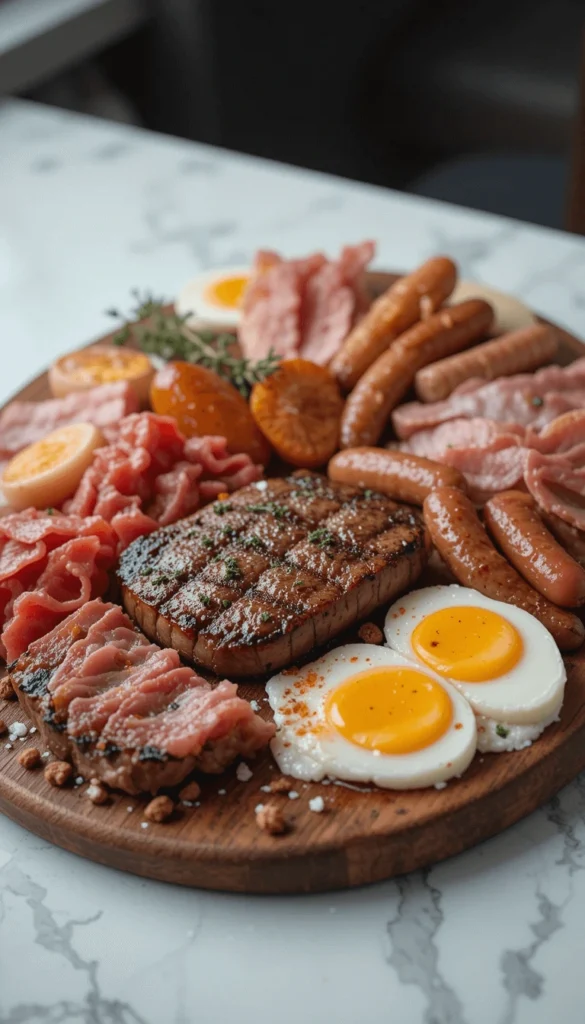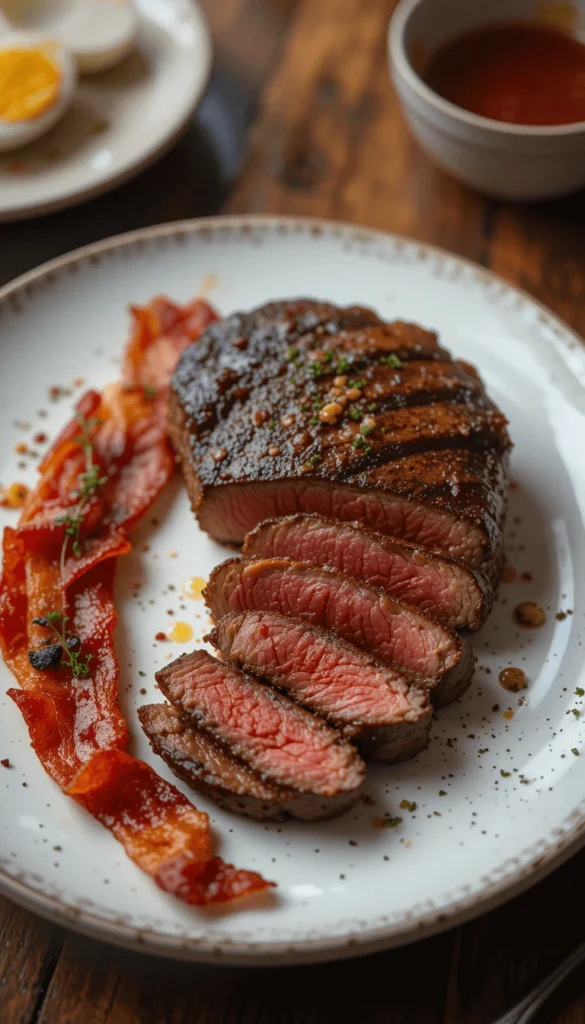Meat-only recipes aren’t just for bodybuilders or extreme dieters—they’re for anyone who wants to simplify eating, reduce inflammation, and fuel their body with nutrient-rich food.
The carnivore diet strips away confusion by focusing on one thing: animal-based nutrition. No tracking carbs. end hidden sugars. No guessing. Just real, satisfying meals built around meat. Whether you’re trying this way of eating for the first time or looking to make your routine easier, this guide brings you meat-only recipes that are as simple as they are filling.
These recipes support fat loss, muscle growth, mental clarity, and long-lasting energy—all without complicated prep or a fridge full of extras. The goal is to make this lifestyle more approachable, not overwhelming.
You’ll find easy steps, quick ingredients, and time-saving tips that keep things practical. With the right approach, eating a carnivore diet isn’t restrictive—it’s freeing. You eat when you’re hungry, stop when you’re full, and enjoy every bite along the way.
This article is built to help you do just that—no gimmicks, no guesswork—just meat, made simple.

Key Benefits of Meat-Only Recipes on the Carnivore Diet
Meat-only recipes do more than simplify cooking—they support your body with the fuel it’s naturally built to use. The carnivore diet eliminates guesswork by focusing on nutrient-dense, easily digestible foods that satisfy hunger and keep you energized. Here’s why these recipes work so well:
1. Naturally Satisfying and Keeps You Full
Meat is packed with high-quality protein and fat—two macronutrients that work together to curb cravings and promote fullness. After a meat-based meal, you’re less likely to reach for snacks or overeat later in the day. That means more stable energy and fewer blood sugar dips.
Bonus: Most people naturally reduce their meal frequency without trying. That’s how satisfying real food can be.
2. Supports Lean Muscle and Fat Loss
The high protein content in meat helps preserve and build lean muscle, especially when paired with strength training. At the same time, the absence of carbs pushes your body to burn fat for fuel. Meat-only meals give you what your body needs to recover, repair, and thrive—without the added sugar or starch.
Tip: Fatty cuts like ribeye or pork belly help you meet energy needs without needing carbs.
3. Reduces Inflammation and Food Sensitivities
Many people report fewer digestive issues, joint pain, and skin problems on a strict carnivore diet. Why? It removes common irritants—like gluten, seed oils, and processed carbs—that often trigger inflammation. You’re giving your gut a break while nourishing it with amino acids, collagen, and healthy fats.
Some even find relief from autoimmune conditions or long-standing food intolerances.
4. Improves Mental Clarity and Focus
With fewer blood sugar spikes and no processed additives, many carnivore eaters experience sharper focus and stable moods. The brain runs efficiently on fat and ketones, and meat provides essential nutrients like B vitamins, zinc, and iron that directly support brain health.
5. Simplifies Your Day and Your Grocery List
Forget the long ingredient lists or complicated meal plans. Meat-only recipes are straightforward, fast to prepare, and easy to scale. Whether you’re cooking for one or meal prepping for the week, these dishes are made to work with your schedule—not against it.
You’ll save time, reduce stress, and still eat well—even on your busiest days.
6. High in Nutrients You Actually Absorb
Meat offers bioavailable forms of nutrients—meaning your body can absorb and use them more efficiently than from plants or supplements. This includes iron, vitamin B12, creatine, and essential fatty acids. You get more out of every bite, without fillers or anti-nutrients.
Organ meats like liver or heart are especially rich in nutrients, and just a small amount goes a long way.
7. Builds Consistency Without Boredom
A lot of people worry that eating only meat will feel repetitive—but when you learn how to cook it right and rotate your cuts, it stays enjoyable. From juicy roasts to crispy pan-seared steak, the textures and flavors can shift dramatically with small changes.
Once you master a few key methods, the diet feels less like a challenge and more like a routine you actually enjoy.
In Summary:
The key benefit of meat-only recipes is freedom. Freedom from bloating, cravings, constant meal planning, and the stress of wondering what to eat next. By going back to the basics, you get more out of every meal—with less effort.
Ingredients — What to Use in a Meat-Only Recipe
Meat-only recipes are all about simplicity. You don’t need an overflowing pantry. You just need quality animal products, the right fat-to-protein balance, and a few basic tools to bring it all together.
Below is a practical list of carnivore-friendly ingredients, grouped by purpose.
1. Main Protein Sources
These meats form the base of most carnivore meals. Choose fattier cuts to maintain energy, especially if you’re eating zero carbs.
- Ribeye steak – rich in fat and flavor
- Ground beef (80/20 or higher) – versatile and affordable
- Chuck roast – perfect for slow or pressure cooking
- Pork belly – crispy when pan-fried, high in fat
- Lamb chops – nutrient-dense and tender
- Chicken thighs or drumsticks – dark meat offers more fat than breast
- Beef short ribs – ideal for slow roasting
- Turkey legs – lean but flavorful, best with added fat
Tip: Grass-fed and pasture-raised meats are great if available, but not required. Prioritize freshness and fat content.
2. Organ Meats (Optional, but Highly Recommended)
Organ meats are nutrient-dense and support full-body health. A little goes a long way.
- Beef liver – high in vitamin A, B12, and iron
- Heart – rich in CoQ10 and protein
- Kidney – supports detoxification
- Tongue – tender and mild when slow-cooked
- Sweetbreads – creamy texture, high in fat and minerals
Tip: If you’re not used to the flavor, try finely dicing and blending with ground beef for an easier transition.
3. Animal Fats for Cooking
Fat is essential on a carnivore diet. It supports energy, hormone production, and flavor.
- Beef tallow – ideal for high-heat cooking
- Duck fat – adds crispness and richness
- Ghee (clarified butter) – dairy-based but tolerated by some
- Pork lard – great for pan-frying and slow cooking
- Suet (raw beef fat) – used for rendering or mixing into ground meat
Tip: Don’t skimp on fat. Lean meat without added fat can lead to low energy or hunger shortly after meals.
4. Optional Extras (Still 100% Carnivore)
These are technically optional but can help add variety or convenience.
- Salt – the only seasoning required for most carnivore meals
- Bone broth – supports hydration, digestion, and joint health
- Eggs – versatile and nutrient-rich
- Raw dairy (if tolerated) – such as aged cheese or cream
- Carnivore-approved jerky or meat sticks – useful for travel or snacking
- Bacon – adds smoky flavor and texture
Note: Choose uncured, sugar-free versions. Always read labels when buying packaged products.
5. Helpful Cooking Tools
Not ingredients, but helpful for making your meals more enjoyable and efficient.
- Cast iron skillet – perfect for searing and oven-finishing
- Sheet pan – useful for batch cooking
- Slow cooker or Instant Pot – great for tougher cuts
- Meat thermometer – ensures proper doneness
- Sharp knife – makes slicing and prep smoother
In Summary
Carnivore cooking doesn’t require complicated ingredient lists. With just a few high-quality meats, some animal fats, and salt, you can create deeply satisfying meals that support energy, focus, and overall health. Stick with what works, keep it simple, and your kitchen will stay stress-free.

Instructions — How to Cook Simple, Satisfying Carnivore Meals
Cooking meat-only recipes doesn’t require fancy techniques. In fact, the best results often come from mastering the basics. Below, you’ll find the core steps used across nearly all carnivore meals, whether you’re working with steak, ground meat, or slow-cooked cuts.
These instructions are adaptable—once you understand the methods, you can apply them to almost any meat you have on hand.
A. Searing Meat (Steak, Chops, Ground Patties)
Searing locks in juices and brings out deep flavor. Use this for cuts like ribeye, lamb chops, or burger patties.
What you need:
- Cast iron skillet
- Tallow, lard, or ghee
- Room temperature meat
- Salt
Steps:
- Remove meat from the fridge 30 minutes before cooking. Pat it dry.
- Heat a cast iron skillet over medium-high heat until hot. Add 1–2 tablespoons of animal fat.
- Salt both sides of the meat generously.
- Place the meat in the pan and do not move it for 2–4 minutes.
- Flip and sear the other side.
- Optional: Reduce heat to low and cook 1–2 minutes longer for medium doneness.
- Rest the meat for 5–7 minutes before slicing or serving.
Tips:
- Don’t overcrowd the pan.
- A meat thermometer ensures perfect results: 130°F for medium-rare steak.
B. Roasting or Baking (Ribs, Whole Chicken, Roasts)
This is ideal for larger cuts or batch cooking.
What you need:
- Oven-safe pan or sheet tray
- Meat thermometer
- Tallow or duck fat
Steps:
- Preheat oven to 300°F (for slow roasting) or 400°F (for crispier edges).
- Pat the meat dry and coat with fat. Season with salt.
- Place in a roasting pan, bone-side down if applicable.
- Cook until the internal temperature reaches 145–160°F (depending on the cut).
- Let it rest 10 minutes before slicing.
Examples:
- Beef short ribs: Roast low and slow, around 300°F for 3–4 hours.
- Chicken thighs: Bake at 400°F for 30–40 minutes until crispy.
C. Ground Meat Meals (Carnivore Skillets or Burgers)
Quick and versatile, ground meat can be cooked on the stovetop in under 15 minutes.
Steps:
- Heat a skillet over medium heat and add fat.
- Add the ground meat and break it apart with a spatula.
- Season with salt. Stir occasionally to prevent sticking.
- Cook until browned and fully done (no pink remaining).
- Optional: Stir in small diced organ meats or cooked eggs.
D. Slow Cooking (Roasts, Shanks, Tongue, Oxtail)
Perfect for tough cuts that turn tender over time.
Steps:
- Place meat in a slow cooker or Instant Pot.
- Add salt and enough bone broth or water to cover the bottom (about 1 cup).
- Cook on low for 6–8 hours (slow cooker) or pressure cook for 60–90 minutes.
- Shred with forks and serve with reserved juices.
Works well with:
- Chuck roast
- Beef tongue
- Pork shoulder
- Lamb shanks
E. Eggs and Fat-Boosted Sides
If your version of carnivore includes eggs or dairy, these can round out a meal.
Scrambled Eggs (with Tallow):
- Heat fat in a skillet over medium heat.
- Whisk eggs with a pinch of salt.
- Pour into the pan and stir gently until set.
- Remove from heat slightly before fully cooked to retain softness.
Beef Fat Fries (No Potatoes Involved):
- Cut strips of beef suet or brisket fat.
- Shallow fry in tallow until browned and crisp.
- Salt and serve with steak or eggs.
Batch Cooking Tips
- Cook large roasts or ground beef in bulk. Portion into containers for grab-and-go meals.
- Use leftovers in omelets, bone broth, or carnivore meatballs.
- Refrigerated cooked meat lasts 4–5 days. Freeze extras if needed.

Pro Tips and Variations — Mastering Carnivore Cooking
Cooking on the carnivore diet can be simple, but mastering it takes a little know-how. These pro tips and variations will help you level up your meals, avoid common mistakes, and keep your carnivore journey exciting and flavorful.
1. Get Creative with Meat Cuts
While the typical carnivore meal may feature beef steak or pork chops, there’s a whole world of lesser-known cuts to explore. Variety keeps things interesting and offers nutritional benefits that more common cuts can’t provide.
- Offals (organ meats) are nutrient-rich and add different textures to your meals. Liver, heart, and kidney are excellent options for added variety.
- Beef oxtail or shank offer collagen and gelatin, which is great for skin, joint, and gut health.
- Pork neck bones and beef neck can make rich, flavorful broths and are full of connective tissue.
2. Master the Fat-to-Protein Ratio
When you’re on a carnivore diet, fat is as important as protein. Fat is your energy source and helps keep you feeling full longer. Choose cuts that balance fat with protein, such as:
- Ribeye steaks (the marbled fat makes them extra tender and flavorful).
- Ground beef (80/20)—the 20% fat content ensures you get enough energy.
- Pork belly—a fat-heavy option that makes deliciously crispy meals.
If you’re following a stricter version of the carnivore diet (e.g., zero-carb), opt for cuts with higher fat content to fuel your body effectively.
3. Slow and Low Cooking for Tough Cuts
Some of the most flavorful cuts of meat come from tougher cuts like brisket, chuck roast, or lamb shank. These meats benefit from slow cooking, which breaks down connective tissues and makes the meat tender. Here’s how to get the best results:
- Slow Cooker: Cook on low for 6–8 hours. Ideal for tougher cuts like beef brisket, pork shoulder, or lamb shanks.
- Instant Pot/Pressure Cooker: When you’re short on time, pressure cooking reduces the cooking time significantly (usually around 60–90 minutes).
This method creates rich, tender meat with incredible flavor, and the bones and fat infuse your meal with essential nutrients.
4. Enhance Flavor with Animal-Based Seasonings
While the carnivore diet is quite minimal in terms of flavoring, it’s not without options. Here’s how to enhance the natural flavors of meat:
- Salt: The primary seasoning on a carnivore diet. It brings out the natural flavors of meat. Try experimenting with sea salt or pink Himalayan salt for variety.
- Bone Broth: A rich, savory addition that boosts flavor and provides essential nutrients. Use it to cook tougher cuts or drizzle over roasted meats.
- Render Animal Fats: Beef tallow, lard, and duck fat not only add flavor but help improve the texture when frying or searing.
- Herbs and Spices (Optional): While strictly carnivore diets typically avoid plant-based seasonings, some followers allow herbs or spices in small amounts. Consider dried rosemary, thyme, or garlic powder for flavor if you’re following a more flexible version of the diet.
5. Grill for Smoky Flavor
Grilling is an excellent way to prepare meat, giving it that desirable smoky char without needing additional fats. It also imparts a distinct flavor that pan-searing or roasting can’t replicate.
- Grill steaks, ribs, and even chicken thighs for a juicy, smoky result.
- Add wood chips to your grill for extra smokiness, especially when cooking larger cuts like pork shoulders or beef brisket.
Remember, grilling over indirect heat can help you avoid charring the outside while still getting the perfectly cooked interior.
6. Avoid Overcooking Meat
Meat-only meals are all about texture and juiciness, so avoid overcooking. Overcooked meat loses its tenderness and flavor. Use a meat thermometer to check for perfect doneness.
- Medium-rare beef: Aim for 130–135°F.
- Medium pork or chicken: Aim for 160°F.
- Well-done: If you prefer well-done meat, don’t go over 170°F.
Resting the meat after cooking for a few minutes allows the juices to redistribute, keeping it moist and flavorful.
7. Experiment with Different Meat Sources
For more variety, try including other animal-based foods like:
- Game meats such as venison, bison, or elk, which are leaner but still full of flavor.
- Fish or shellfish like salmon, shrimp, or lobster (if you follow a more flexible version of the carnivore diet). These options are rich in omega-3s and healthy fats.
8. Keep It Simple and Focused
The beauty of carnivore cooking lies in its simplicity. The goal is not to overcomplicate meals but to enjoy the natural flavors of meat in their purest form. A well-cooked steak with a bit of salt is often all you need.
In Summary:
Carnivore cooking can be flavorful, satisfying, and versatile if you know a few tricks. Whether you’re cooking quick ground beef patties, slow-braising tougher cuts, or exploring game meats, these pro tips will help you make the most of your ingredients and enjoy the process along the way.

Serving Suggestions — Enjoying Meat-Only Meals
While the carnivore diet is focused on animal-based foods, there are plenty of ways to make your meals feel exciting and well-rounded. Here are some serving suggestions that complement your meat-only dishes, enhance your dining experience, and keep things simple.
1. Serve with Bone Broth for Added Richness
A warm cup of bone broth can elevate any meat-based meal. It’s especially great with tougher cuts or when you’ve made slow-cooked dishes like roasts or ribs. Bone broth adds flavor, helps with hydration, and provides important minerals like collagen, which supports joint and skin health.
- How to serve:
Pour hot bone broth into a bowl and serve alongside your main protein. Use it to soak up the juices from roasted or grilled meats. - Variation:
You can also drizzle bone broth over steaks or slow-cooked meats to add moisture and flavor.
2. Pair Meat with Simple Salads (Optional for Flexibility)
While the traditional carnivore diet avoids plant-based foods, some variations of the diet allow small amounts of vegetables, particularly those with low carb content. A simple salad with carnivore-approved options like spinach or arugula can add a refreshing contrast to rich meats.
- How to serve:
Toss fresh greens with a little salt and carnivore-approved fat, such as olive oil or bacon grease. Serve as a side to a fatty ribeye steak or grilled chicken. - Tip:
Keep the salad simple—avoid dressing or other non-carnivore ingredients if you’re following a strict version of the diet.
3. Eggs as a Side or Topping
Eggs are a perfect complement to many carnivore meals. They’re rich in protein and healthy fats, making them a versatile addition to your plate. Scrambled, fried, or soft-boiled eggs can provide an extra source of nutrition and flavor to your meat-based meals.
- How to serve:
Serve scrambled eggs with crispy bacon or fried eggs on top of a juicy steak for a decadent meal. You can also cook eggs in tallow or butter for added richness. - Variation:
For a change of pace, make a meat and egg scramble using leftover cooked meat like ground beef or chicken, mixed with eggs and cooked together.
4. Serve with Carnivore-Approved “Sides”
Though the carnivore diet is meat-centric, some followers include additional animal-based “sides.” These additions help round out the meal while keeping everything in line with carnivore principles.
- Beef tallow fries: Slice fat or suet into thin strips and fry in beef tallow until crispy.
- Pork rinds: Great as a crunchy snack or side dish for dipping into meat drippings.
- Cheese (if tolerated): High-fat cheeses like cheddar, mozzarella, or gouda are occasionally added for extra flavor.
5. Make Meat Skewers or Kebabs
Skewers are an easy way to serve different cuts of meat on a stick, making meals more fun. This works great for grilling or roasting. Combine cuts like chicken thighs, pork belly, and beef cubes on the same skewer for a variety of flavors in every bite.
- How to serve:
Arrange different types of meat on skewers and cook over a grill or in the oven. Serve with a side of dipping sauce made from animal fats. - Variation:
Try adding a few small pieces of fatty fish like salmon for variety (if your version of the carnivore diet permits fish).
6. Create a Meat Platter
For a more elegant approach, consider serving a meat platter. A carnivore meat platter is perfect for special occasions or when you want a visual impact.
- How to serve:
Arrange different meats like sliced roast beef, charcuterie, pork belly, sausages, and crispy skin-on chicken thighs. You can include small portions of beef liver or pate for extra richness. Add a few slices of hard cheese if you’re not strictly avoiding dairy. - Tip:
For a quick meat platter, include leftovers from your previous meals. Arrange everything neatly and enjoy a variety of textures and flavors.
7. Serve with Sauces Made from Animal Fats
While the carnivore diet avoids most plant-based condiments, animal fat-based sauces can elevate your meal without breaking the rules. Use rendered fats from your meat or make simple sauces to complement your dishes.
- How to serve:
Drizzle beef tallow or duck fat over steak or grilled meats. You can also make a basic cream sauce from heavy cream and butter for dishes like roast chicken. - Variation:
If you tolerate dairy, try a cheese sauce made from cream and cheese to accompany meats like pork chops or lamb.
8. Serve on Simple Meat Boards or Platters
For a family-style meal or when serving guests, meat boards allow everyone to pick and choose their favorite cuts. It’s a fun way to enjoy various meats without too much effort in preparation.
- How to serve:
Arrange a selection of meats, such as cold cuts, grilled steaks, and slow-cooked meats, on a large platter. Pair with a few eggs, cheese, and carnivore-approved sides.
In Summary:
Serving carnivore meals is about simplicity, variety, and focusing on the natural richness of meat. Whether you’re pairing your steak with bone broth or serving up a meat platter for a group, these serving suggestions keep your meals satisfying and enjoyable.

Conclusion — Simplifying Your Carnivore Diet Journey
The carnivore diet, at its core, is about embracing the simplicity and nutritional power of animal-based foods. Whether you’re a seasoned carnivore or just getting started, these meat-only recipes will make it easier to prepare flavorful, satisfying meals without the fuss.
By focusing on high-quality cuts of meat, using time-tested cooking methods like searing, roasting, and slow cooking, and experimenting with different fat ratios and meats, you can create meals that not only fuel your body but also keep your palate excited.
Key Takeaways
- Variety in Meat Cuts: Don’t be afraid to explore different cuts like beef oxtail, pork belly, and organ meats. Each offers unique flavors and nutrients.
- Fat is Essential: Whether it’s ribeye steak, ground beef, or pork shoulder, ensure your meals contain a good balance of fat to keep you feeling satisfied and energized.
- Simple Cooking Methods: From grilling to slow cooking, mastering basic techniques can help you make the most of every cut of meat.
- Flexibility in Meal Design: While the carnivore diet is meat-centric, you can experiment with various fats, eggs, and, occasionally, small amounts of dairy or low-carb veggies to enhance flavor and texture.
Stay Focused and Enjoy the Journey
The simplicity of the carnivore diet lies in its ability to offer wholesome, satisfying meals that require minimal preparation. You don’t need fancy ingredients or complex recipes to reap the benefits. With the right approach, you’ll find that eating meat-only can be enjoyable, versatile, and deeply nourishing.
Stay committed to exploring different cuts, cooking methods, and serving ideas. As you progress, you’ll discover your personal preferences and how to best fuel your body with the power of animal-based foods.
Let this be your go-to guide as you simplify your meals and embrace the carnivore diet with confidence.
FAQs — Common Questions About the Carnivore Diet
The carnivore diet is an extreme but growing dietary approach that focuses entirely on animal-based foods. As more people explore this lifestyle, common questions and concerns arise. Below, we’ve compiled and answered some of the most frequently asked questions to help you navigate your carnivore journey.
1. What exactly can I eat on the carnivore diet?
On the carnivore diet, you eat only animal-based foods. This includes:
- Meats: Beef, pork, chicken, lamb, venison, etc.
- Fish and seafood (if your version allows it).
- Eggs: A great source of protein and fat.
- Animal fats: Beef tallow, lard, duck fat, etc.
- Cheese: If tolerated (optional in strict carnivore versions).
- Organ meats: Liver, heart, kidney, etc.
You avoid all plant-based foods like vegetables, fruits, grains, and legumes.
2. Can I lose weight on the carnivore diet?
Yes, many people experience weight loss on the carnivore diet, primarily due to a reduction in carbohydrate intake and a shift toward burning fat for energy. The high-protein and high-fat meals also help you feel fuller for longer, reducing overall calorie consumption.
However, individual results may vary, and it’s important to consult with a healthcare professional before making drastic dietary changes.
3. How do I get enough nutrients on the carnivore diet?
The carnivore diet provides essential nutrients like protein, fats, and important micronutrients (e.g., iron, vitamin B12, and zinc) naturally found in animal products. To ensure you’re getting a broad range of nutrients:
- Eat a variety of meats: Including organ meats like liver, which are packed with vitamins and minerals.
- Include eggs: These provide high-quality protein and essential fatty acids.
- Consider bone broth: Rich in collagen, bone broth can provide important minerals and help support joint and gut health.
In some cases, you may need to supplement with vitamins such as Vitamin D or magnesium, but these should be discussed with a healthcare professional.
4. What are the potential side effects of the carnivore diet?
While many people thrive on the carnivore diet, some may experience side effects, especially during the initial transition. Common side effects include:
- Keto flu: Similar to the low-carb ketogenic diet, some people experience fatigue, headache, and irritability as the body adapts to burning fat instead of carbohydrates.
- Digestive changes: Some people may experience constipation or changes in bowel movements due to the lack of fiber.
- Electrolyte imbalances: Reduced intake of fruits and vegetables may lead to deficiencies in potassium or magnesium.
These side effects tend to subside after the body adjusts, but it’s important to stay hydrated, consider electrolyte supplementation, and adjust your diet as needed.
5. Can I have coffee or tea on the carnivore diet?
Strict carnivore diets typically avoid beverages other than water, bone broth, and sometimes herbal teas. However, many followers of a more flexible approach allow themselves black coffee or unsweetened tea, as these beverages don’t contain carbs or plant-based ingredients.
It’s important to monitor how your body reacts to these drinks. If they cause cravings or digestive discomfort, consider eliminating them for a period.
6. Is the carnivore diet safe for everyone?
While the carnivore diet has many proponents, it’s not suitable for everyone. People with certain medical conditions, such as kidney disease, may need to avoid excessive animal protein. Additionally, those with specific dietary needs or sensitivities (e.g., to cholesterol) should consult with a healthcare provider before starting.
It’s also essential to listen to your body and adjust the diet based on how you feel. Always consider working with a healthcare provider, particularly if you have pre-existing health concerns or are planning to follow the diet for a prolonged period.
7. Can I combine the carnivore diet with other diets or intermittent fasting?
Yes, many people combine the carnivore diet with intermittent fasting. This involves cycling between periods of eating and fasting, which can enhance weight loss and metabolic health. However, it’s important to start slowly and assess how your body responds.
As for combining the carnivore diet with other dietary approaches (e.g., keto), it’s essential to evaluate your goals and how these diets interact with your body’s needs. Some find that the carnivore diet works best as a standalone approach, while others use intermittent fasting or keto as complementary practices.
8. Can I enjoy carnivore-friendly snacks?
While the focus of the carnivore diet is on whole meals, there are a few snack options that can fit within the guidelines, such as:
- Hard-boiled eggs
- Beef jerky (preferably with no added sugars or carbs)
- Pork rinds
- Cheese (if tolerated)
- Cold cuts or leftover meat
These snacks are perfect for staying on track between meals or when you need a quick protein boost.
9. Can I have dairy on the carnivore diet?
Dairy is a controversial topic on the carnivore diet. Some followers allow high-fat dairy like cheese, butter, and cream, while others avoid it altogether, as it is derived from cows. The decision to include dairy depends on your specific version of the carnivore diet and personal tolerance.
If you include dairy, opt for full-fat, minimally processed options and observe how your body reacts. If dairy causes inflammation or digestive discomfort, it may be best to remove it from your diet.
10. Will I get bored eating just meat?
Eating a meat-only diet doesn’t have to be boring. In fact, it offers more variety than most people realize. By experimenting with different cuts of meat, cooking methods (grilling, slow cooking, roasting), and exploring organ meats, you can enjoy a range of flavors and textures that will keep your meals satisfying.
Additionally, using seasonings like salt, animal fats, and occasional sauces can help add new layers of flavor to your dishes.
Final Thoughts:
The carnivore diet offers a simple and effective way to nourish your body with nutrient-dense animal foods. With the right approach, it can be fulfilling and easy to follow. If you’re new to the diet or considering it, take it one step at a time and listen to your body’s needs.
Check out more tips and recipes for cooking on a Blackstone Griddle at Blackstone Products, the official website for griddles and cooking accessories.
Looking for more simple, high-protein meal ideas? Check out our guide on Easy Blackstone Griddle Recipes You’ll Make Again and Again.
